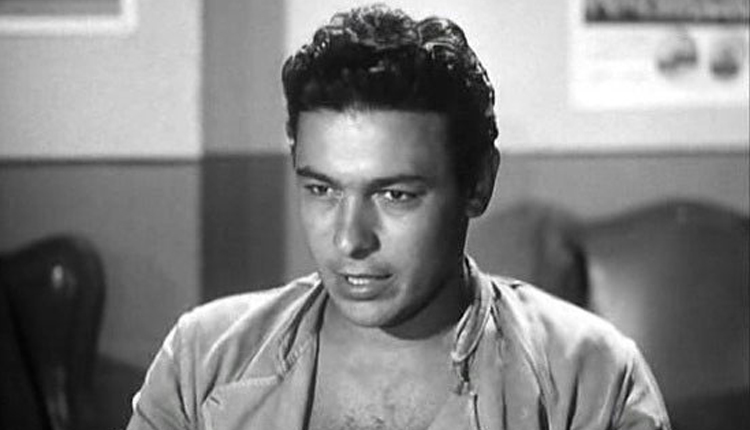Egyptian Ahmed Ramzy’s debut in Our Sweet Days in 1955 shifted cinema at the time, influencing filmmakers to move toward taking the risk of hiring younger actors. Prior to Ramzy’s appearance, many roles were held by older actors who were often visibly beyond an age to convincingly play younger characters.
Born 23 March 1930 to an Egyptian father and a Scottish mother, Ahmed Ramzy developed a reputation on-screen as a charismatic playboy, a daring and charming troublemaker.
Ahmed Ramzy, with his open, vibrant character and unbuttoned shirts helped usher in the first wave of youth films in Egyptian cinema. Omar Sherif’s debut in Conflict in the Valley in 1954 also contributed to the shift.
However, Ramzy’s persistence on presenting this persona’s outward features in a stronger, clearer way than Omar El-Shraif, who was soon attracted to the dream of the Western cinema, made Ramzy’s name goes hand in hand with the youth films, especially that he remained in the four subsequent years playing this kind of roles almost solely.
Ahmed Ramzy became known for taking roles in youth films, along with Omar Sherif however Sherif was drawn to enter the world of Western cinema.
In 1959 Hassan Youssef also entered the scene, along with Youssef Fakhreddine who debuted in 1957.
With the advent of the 60’s, these four became known for their parts in youth and adventure films.
In his early roles, Ahmed Ramzy didn’t care about the size of the role nor with being described as the leading man or a co-star. However, he was the leading man in Love and Tears, his second role in which he starred alongside Faten Hamama.
However, his roles across his first ten films ranged between second leading man as in Days and Nights and Chahine’s Conflict in the Harbour and joint leading roles such as Sky Devils with Shokri Serhan, Abdel-Salam Al-Nabulsi and Abdel-Moniem Ibrahim.
By the end of the 1958, Ramzy has acted in twenty seven films, including nine films in 1958 alone. Undoubtedly, this propelled him into becoming a household name. From his total filmography of one hundred films across forty-eight years, a quarter of his entire output was during his first four years as an actor.
Although the fortunes of Ahmed Ramzy took a hit with the emergence of Hassan Youssef and Youssef Fakhreddine, he quickly came back into demand.
Filmmakers realised the potential of combining Ramzy, Youssef and Fakhreddine in one film, or at least two of them together, along with comedians such as Abdel-Moniem Ibrahim or Mohamed Awad. As a result, a particular type of film dominated the cinema screens during this era, relying on a masculine vigour and adventurousness, and joint leading roles.
The dominance of such films can be traced to social and political dynamics at the time.
Under Nasser, there was a growth of the educated middle class and an increase of women going to work; this lead to a desire for people to have access to entertainment, and going to the cinema became a popular pastime. This saw an end of the peasant dramas that prevailed in 1950s, in favour of family dramas – particularly light comedies and adventure films.
Ahmed Ramzy starred in a range of family films from this era such as The Bridegroom Will Arrive Tomorrow, Zizi’s Family, A Husband’s Confessions, A Marriage in Danger, The Wedding Night, and Only for Married People.
With the arrival of the talented Soad Hosni, 1960s cinema shifted with filmmakers embracing the theme of the honey-pot; an outgoing girl at the centre of men’s attention. Ahmed Ramzy starred alongside Soad Hosni, notably The Three Miscreants, Girls’ Naughtiness and The Three Adventurers.
Between the 1967 Defeat and 1973 October War victory, decision-makers wanted to pull people’s attention away from the troubles through cinema. With the decline of Nasser and the ascendancy to the presidency by Anwar Sadat in 1970, there was continuation of light comedies, adventure and films with joint-leading roles dominating the screens.
This explains the slowing of Ahmed Ramzy’s films post 1967 in comparison with his previous output, as Egyptian cinema was impacted by the instability. There was almost a collective immigration of people from the creative industries following the 1967 Defeat, which impacted which the Egyptian cinema.
In spite of all this, Ramzy made some important films in the early 70s such as Adrift on the Nile and Love in the Rain, both adapted from novels by Naguib Mahfouz.
Ramzy also ventured outside the Arab world, and it is noteworthy to mention his experiences particularly in Italian cinema. He participated in Italian films, The Son of Spartacus, I giardini del diavolo, Heroes Without Glory, Si può fare molto con 7 donne, and You Can Do A Lot With Seven Women. These experiences failed to satisfy Ramzy, and he acknowledged them as uncalculated ventures.
By the mid-70s, Ramzy couldn’t find suitable roles and was struggling to accept he had grown beyond the youth roles that had defined his early rise to fame. This was evidence from the fact that he only appeared in two films between the years 1976 and 1981.
The first was The Youths’ Madness produced in 1972, yet wasn’t released until 1976 due to censorship. The second was A Tale behind Every Door, which was initially independent television episodes starring Faten Hamama, but were then collected and released in cinemas in 1981.
Ramzy didn’t act again in a film for almost twenty years. He then starred along Nelly in The Desert Cat in 1990 and with Youssra in his final film The Red Rose in 2000.
Ramzy appeared twice in a TV series; first with lifetime friends Faten Hamama in The Face of the Moon in 2000 and second with Omar Al-Sharif in Hanan and Haneen in 2007. Despite his audacious on-screen persona, Ahmed Ramzy valued his privacy and withdrew from public life. He quietly passed away at his home in the North coast on 28 September 2012.
Source: Ahram Online



